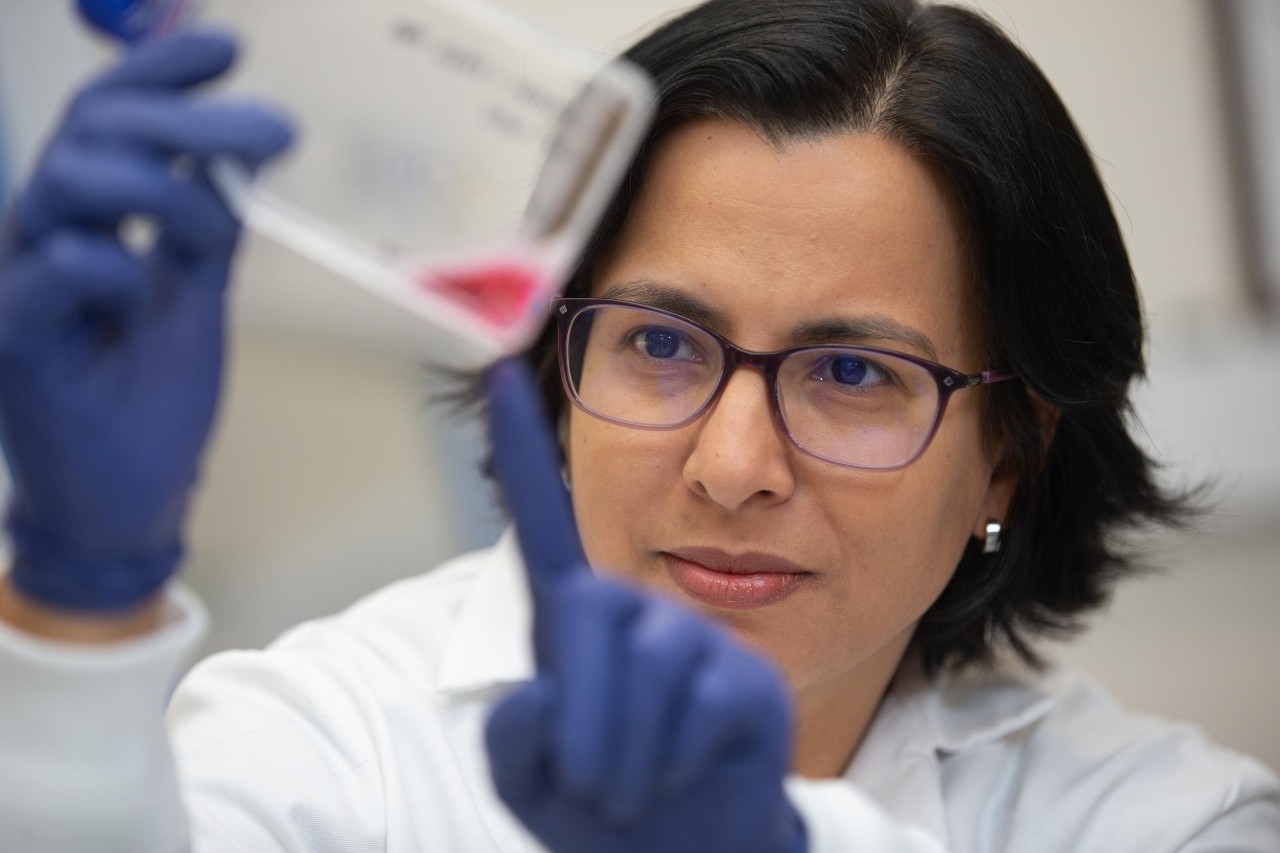
UC biologists target lifecycle of deadly parasite
Chagas disease kills thousands each year
Chagas disease is often called a silent killer because many people don’t realize they have it until complications from the infection kill them.

Assistant Professor Noelia Lander studies molecular parasitology in UC's College of Arts and Sciences. Photo/Andrew Higley/UC Marketing + Brand
Researchers at the University of Cincinnati are exploring ways to interrupt the lifecycle of the parasite behind the illness, offering hope of developing a cure.
The disease is spread by parasites found in kissing bugs, which suck the blood of people when they are sleeping. The bugs typically bite victims around their faces, which gives them their ironically sweet-sounding name. The bugs transmit the internal parasites in their poop, which infects the bloodstream of human hosts through the bite wounds.
The study was published in the journal mBio, from the American Society for Microbiology.
Chagas disease is found across North and South America. Between 6 and 8 million people are believed to be infected, including 300,000 living in the United States, according to federal health data. But many only realize they are infected when they develop symptoms decades later. The parasites cause gastrointestinal and neurological impairments and enlargement of the heart, which can lead to cardiac arrest.

UC graduate Joshua Carlson holds up a container of uninfected kissing bugs, the insect responsible for transmitting Chagas disease. Photo/Andrew Higley/UC Marketing + Brand
“The main issue with Chagas disease as a public health problem is that most people don’t know they’re infected until symptoms appear and it’s too late to treat them,” UC Assistant Professor Noelia Lander said.
In her molecular parasitology lab, Lander and her students are studying the complex lifecycle of the parasite to find vulnerabilities to exploit.
The parasite is a tiny single-celled organism that undergoes four lifecycle changes to survive and reproduce on its odyssey from the digestive system of an insect to the bloodstream of a human and back. Along the way, it must be able to withstand dramatic differences in its environment such as acidity, temperature and the availability of nutrients.
The goal is to find its weaknesses to fight the disease.
Noelia Lander, UC College of Arts and Sciences
The parasite attaches itself to the hindgut of the kissing bug’s digestive tract with a tail called a flagellum and transforms to be infective. And when poop from the kissing bug infects a bite wound, the parasite enters a person’s body where it infects cells of all kinds: nerve cells, muscle cells, white blood cells. Inside these cells, it transforms again, losing its flagellum and replicating many times. Eventually, the cell bursts, releasing infective forms that can spread the infection to other cells.
The parasite has been living on Earth for millions of years — long before people.
“I know the parasite is the enemy. But I’m impressed by the mechanisms the parasite has to survive during its lifecycle,” Lander said. “The goal is to find its weaknesses to fight the disease.”
UC graduate Joshua Carlson was lead author of the paper. Co-author and UC doctoral student Milad Ahmed said the parasite hides within the cells it infects in human tissues, helping it to evade both the immune system and medications. Once the disease becomes chronic, treatments become significantly less effective, he said.
The parasite's genes further complicate efforts to develop effective vaccines or universally applicable treatments, Ahmed said.

Assistant Professor Miguel Chiurillo is studying insect-borne illness in UC's College of Arts and Sciences. Photo/Andrew Higley/UC Marketing + Brand
Researchers used gene-editing tools to manipulate the genes of the parasite. The aim was to identify the location and function of one of the proteins that helps the tiny parasite adapt, study co-author and UC Assistant Professor Miguel Chiurillo said.
Chiurillo said UC researchers targeted a signaling pathway that controls cues for the parasite’s survival within the kissing bug.
“Two main functions are important to survive inside a kissing bug: to replicate inside the bug and to attach to the digestive tract,” he said. “If we can block this interaction, we can stop the spread of the disease.”
Lander said interrupting the parasite’s lifecycle is a promising target for future medical treatments.
“If the parasite can’t transform during its lifecycle, it won’t survive,” she said.
The research was supported by the National Institute of Allergy and Infectious Diseases.
Featured image at top: UC Assistant Professor Noelia Lander is studying ways to disrupt the lifecycle of the parasite behind Chagas disease in her molecular parasitology lab. Photo/Andrew Higley/UC Marketing + Brand

Assistant Professor Noelia Lander teaches in the Department of Biological Sciences in UC's College of Arts and Sciences. She has extensive experience investigating tropical and emerging global diseases. Photo/Andrew Higley/UC Marketing + Brand
Next Lives Here
The University of Cincinnati is leading public urban universities into a new era of innovation and impact. Our faculty, staff and students are saving lives, changing outcomes and bending the future in our city's direction. Next Lives Here.
Related Stories
Don't make it easy for thieves to steal your car
January 9, 2026
Professor Cory Habermann speaks to Spectrum News 1 on car theft.
Money matters
January 9, 2026
A Lindner-led team led by University of Cincinnati PhD candidate Sharmeen Merchant published “Gender Differences on Dual-Earners’ Money as Achievement Congruence and Needs-Supplies Fit" in the Journal of Business and Psychology. This research took an in-depth look at the psychological role money plays in households with two sources of income, and showed how a couple's alignment on financial needs impacts job fulfillment.
The biggest skin-care trends of 2026 go back to basics
January 8, 2026
The University of Cincinnati's Kelly Dobos was featured in an Allure article discussing the biggest skin-care trends of 2026.
